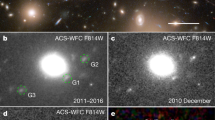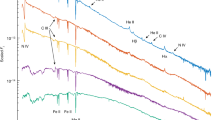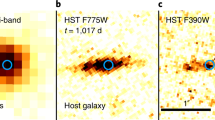Abstract
Recent studies using the Very Large Array (VLA) telescope have revealed the existence of two unusual extended non-thermal sources, G357.7–0.1 and G5.3–1.0 (refs 1,2). Classified earlier as supernova remnants (SNRs), these sources have a marked axial symmetry and compact sources on the axis at one edge. We have now looked for counterparts of these sources in the Infrared Astronomical Satellite (IRAS) Point Source Catalogue and find an IRAS source showing the characteristic spectrum of an early type star embedded in a dusty cloud, coincident with the compact source in G357.7–0.1. We propose that the compact object is an O star whose formation was triggered by the shock front of the diffuse radio source.
This is a preview of subscription content, access via your institution
Access options
Subscribe to this journal
Receive 51 print issues and online access
$199.00 per year
only $3.90 per issue
Buy this article
- Purchase on Springer Link
- Instant access to full article PDF
Prices may be subject to local taxes which are calculated during checkout
Similar content being viewed by others
References
Shaver, P. A., Salter, C. J., Patnaik, A. R., van Gorkom, J. H. & Hunt, G. C. Nature 313, 113–115 (1985).
Becker, R. H. & Helfand, D. J. Nature 313, 115–118 (1985).
Shaver, P. A. et al. Astr. Astrophys. 147, L23–L24 (1985).
Beichman, C.A., Neugebauer, G., Habing, H.J., Clegg, P. E. & Chester, T.J. (eds), Infrared Astronomical Satellite Catalogs and Atlases, Explanatory Supplement (US Government Printing Office, Washington, DC, 1984).
Bennett, C. L., Lawrence, C. R., Garcia-Barreto, J. A., Hewitt, J. N. & Burke, B. F. Nature 301, 686–688 (1983).
Scoville, N. Z. & Kwan, J. Astrophys. J. 206, 718–727 (1976).
Panagia, N. Astr. J. 78, 929–934 (1973).
Mezger, P. G. Astr. Astrophys. 70, 565–574 (1978).
Clark, D. H. & Caswell, J. L. Mon. Not. R. astr. Soc. 174, 267–305 (1976).
Ezer, D. & Cameron, A. G. W. Can. J. Phys. 45, 3429–3460 (1967).
Helfand, D. J. & Becker, R. H. Nature 313, 118–119 (1985).
Wootten, H. A. Bull. Am. Astr. Soc. 8, 323 (1976).
Odenwald, S. F. et al. Astrophys. J. 279, 162–165 (1984).
Liszt, H. S. & Burton, W. B. Astrophys. J. 236, 779–797 (1980).
Author information
Authors and Affiliations
Rights and permissions
About this article
Cite this article
Rengarajan, T., Verma, R. Shock-induced star formation in G357.7 – 0.1?. Nature 317, 415–416 (1985). https://doi.org/10.1038/317415a0
Received:
Accepted:
Issue Date:
DOI: https://doi.org/10.1038/317415a0
Comments
By submitting a comment you agree to abide by our Terms and Community Guidelines. If you find something abusive or that does not comply with our terms or guidelines please flag it as inappropriate.



